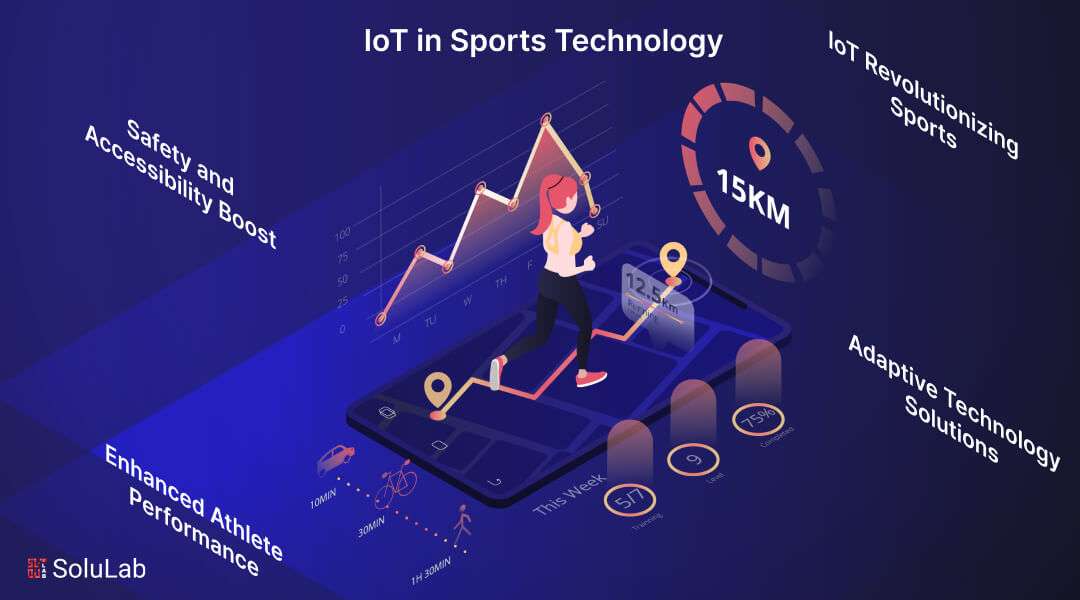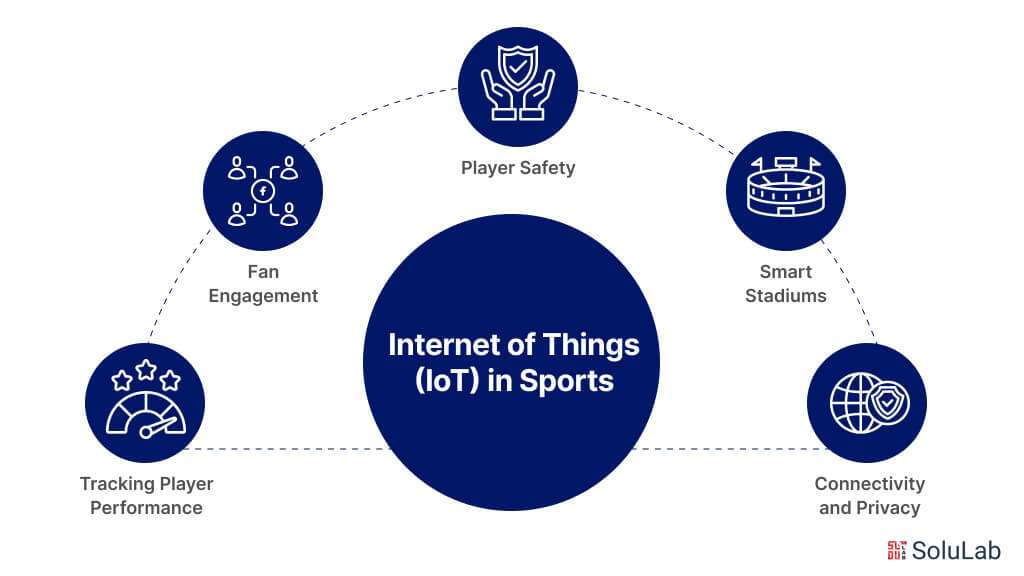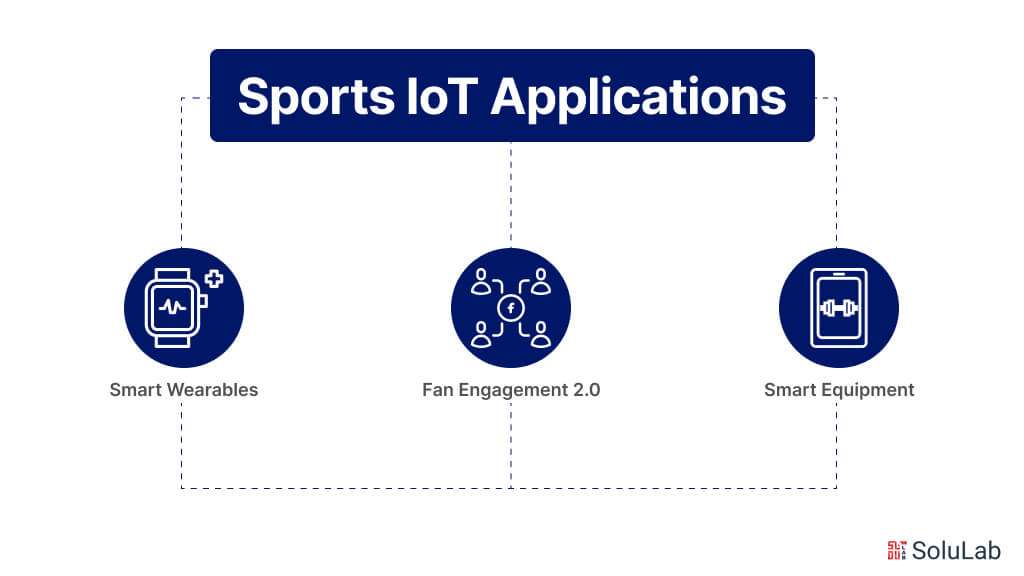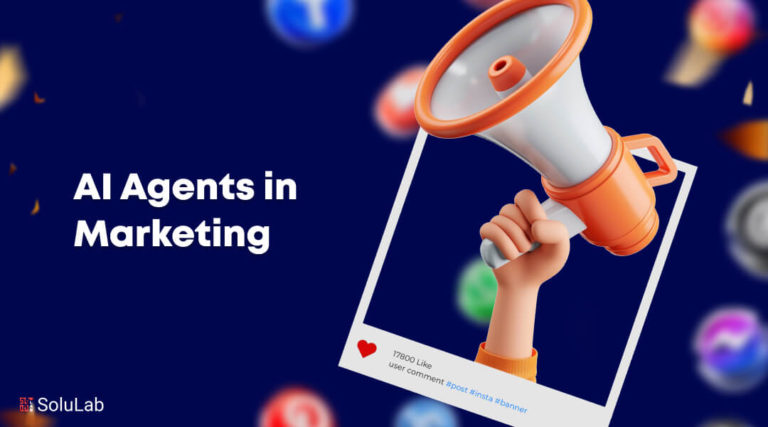
We live in a world filled with Fitbits, smartwatches, PlayStations, smart TVs, smarter stadiums, virtual reality goggles, and other gadgets in 2024. Almost everyone has been impacted by this digitally revolutionary change in a wide range of businesses, and the sports sector is no exception. These Internet of Things gadgets are widely available, regardless of whether you’re an athlete, fitness fanatic, or just a fan. Not only that, but major sports brands like Asics, Under Armour, and Adidas have entered this market with their own sports applications, such as Edmondo and Runtastic. The use of technology in sports is changing operations, strategies, training, techniques, and even fan interaction, so it’s no longer just a get, set, match situation. Using these networked physical objects and bridging the communication gap between businesses even in the absence of human connection, any IoT development firm today is at the forefront of the digital revolution.
Sporting tech, another name for IoT in athletics, is a field that focuses largely on changing the sporting environment. On the other hand, if you stay up-to-date with the sports tech industry online, you may be familiar with Microsoft’s smart Internet of Things-powered cricket bat. That bat had a card-sized sensor that used motion sensors to gather immersive data like as angles, speed, swing, and more. Additionally, it monitored the spin and swing in various conditions with success. Some of these linked sports have even adopted the capacity to measure performance and communicate the same data to their individual cellphones. These connected sports, when paired with the quality of machine learning algorithms, retrieve exact data-based outcomes. It follows that the phenomenal and ongoing expansion of IoT in the sports business is not surprising. The inception of IoT adoption in the sports sector may be dated back to 2010, despite the lack of a specific chronology.
IoT-Powered Digital Transformation in Sports
Research teams from sports organizations and institutions have amassed an incredible quantity of data and statistics via proof-of-concept studies and pilot initiatives. A number of well-known international sports leagues, including F1, the NFL, NBA, MLB, and EPL, have taken an active role in incorporating IoT into their everyday operations and have committed significant time and money to this effort.
Some startling yet credible market research figures that are pertinent to committed IoT developers are as follows:
- If the compound annual growth rate (CAGR) of smart sports equipment is estimated at 8.2%, the market size prediction will be a staggering $3.74 billion.
- Merely e-commerce has the potential to witness a 7.4% compound annual growth rate increase between 2022 and 2030.
- Furthermore, it is anticipated that the remote health monitoring market would develop at a rate higher than 12.8% between 2022 and 2030.
The boundaries and standards of technology have been effectively defined in closing the gap between basic sports needs and the digital sphere. In addition to fostering a sense of trust among regular users, the growing concept of “smart stadiums” has the potential to be the true game-changing element in the Internet of Things. More factual decisions will also be made as a result of the real-time data combined with speedier connection, whether it be for professional sports events or amateur fitness advancements.
Internet of Things (IoT) in Sports

For more than ten years, the sports sector has seen tremendous growth and transformation because to the use of IoT wearables. Massive benefits are being provided by IoT in sports, including automated ticketing, customized fan experiences, stadium monitoring, injury data, and much more. Let’s examine how the sports business is utilizing the advantages of IoT.
-
Tracking Player Performance
With the advent of game-changing technology like as anxiety monitoring systems (AMS), inertial measurement units, heart rate monitors, and motion capture systems, it is now possible to analyze players in great detail and save their data in the appropriate IoT clouds. The athlete’s present health status and any medical disorders, such as depression, movement abnormalities, energy expenditure, heart rate, stress, cardiovascular statistics, anxiety, and panic disorder, can also be identified with the use of this data. To improve performance overall, it also incorporates the player’s physiological and psychological anxiety measures.
-
Fan Engagement
Now, when criteria are being created, this is a topic that will come up in each meeting that an IoT development business may have. Sports venues are utilizing a lot of IoT both on and off the field to provide spectators the most immersive digital experience possible. Smart Internet of Things (IoT) technologies are being widely implemented by sports groups in an effort to lure fans off the couch and into the seats of the stadium. Associations are placing a strong emphasis on this fan-centric strategy in an effort to interact and thrill spectators from all across the arena.
-
Player Safety
Player security and safety are paramount in the sports industry. Safety in sports is changing as a result of IoT usage. This segment’s state-of-the-art technology influence how doctors, physiotherapists, and other medical professionals assist the athletes in receiving accurate treatments. The ability to track in real-time with embedded sensors and an overall picture of player performance has been made possible by IoT devices and technology. This lets companies make decisions that are best for their players.
-
Connectivity and Privacy
IoT in sports is expected to undergo even more transformation with the rollout of 5G technology. Real-time data processing and transmission will be made possible by faster and more dependable connectivity, opening up new possibilities for prompt decision-making both on and off the field. In terms of data security and privacy, the volume of information gathered by IoT devices is growing quickly, indicating that data privacy is required. Sports organizations are now having trouble finding a balance between protecting players’ personal information and using statistics to improve performance.
-
Smart Stadiums
The possibilities for smart stadiums are virtually limitless, ranging from over 2000 TV screens to 90,000 square feet of LED video displays, complete with 360-degree HD video halo boards and innumerable wifi hotspots. Studies have shown a wealth of opportunities related to venue optimization that are concealed. The implementation of measures such as crowd control, security, and intelligent ticketing has led to a significantly more economical solution and improved use of available resources.
Sports IoT Applications

Professional athletes are not the only ones who may profit from IoT in sports. Wearable technology may be used by fitness enthusiasts and amateur athletes to track their personal progress and performance. Moreover, IoT-enabled gadgets are used in sports rehabilitation programs to help injured athletes heal more quickly and effectively. Let’s examine a few thoughtful Internet of Things applications in the sports industry:
1. Smart Wearables: Wearable Sports use of Internet of Things devices has increased. Smart clothing, fitness trackers, and biometric sensors that monitor blood pressure, body temperature, and muscle fatigue are all used by athletes nowadays. Coaches and trainers may modify training plans to meet individual needs thanks to the real-time data that provides them with critical insights.
2. Smart Equipment: Intelligent sports equipment has increased in the sports market thanks to IoT, from linked basketballs that analyze shooting mechanics to smart footballs that detect spin and trajectory. Athletes may improve their abilities with precision thanks to this data-driven approach, which also gives coaches real-world performance numbers.
3. Fan Engagement 2.0: Fans are more than simply watchers who yell at their favorite players from the comfort of their living rooms. With the emergence of IoT-powered interactive wearables, fans are now actively participating in a fully immersive experience rather than only being spectators. Smart wristbands and jerseys provide fans the opportunity to actively participate in the live game. By syncing with the activity on the field, these gadgets may provide haptic feedback or light up in response to significant events, fostering a closer bond between supporters and their favorite teams.
Performance Analytics: More advanced performance analytics are possible with IoT wearables and their applications in sports. Motion sensors and cameras gather accurate data throughout training sessions and games, enabling a detailed analysis of player movements, positioning, and tactical decisions. Teams make better planning and gain a competitive edge by using this knowledge.
Is Sports Technology Enhanced by IoT?
Even the biggest sporting events used to need painstaking calculations or even a game of cowardly guessing. But since the sports sector has adopted IoT, the difficulties in gathering precise and timely data have completely disappeared. Wearable IoT technology has not only closed the gap between fitness and sports, but it has also raised the bar for performance tracking measures. Let’s examine some significant achievements made by the wearables and IoT sensor industries in recent years:
-
Authentic Data
Wearables with real data from the Internet of Things provide a wealth of capabilities for performance measurement and optimization. Because all of the data for those sensor-smart wearables comes directly from the player’s body or equipment, they don’t need manual entry or human observations, allowing for a dependable and trustworthy estimate and outcome.
During competitions and game trials, real-time performance monitoring navigators are made possible by IoT technology. One of the benefits of being an athlete is that they can always monitor their heart rate, distance traveled, speed, and other pertinent metrics. The coaches can make adjustments to performance by using this data remotely. Studies have shown that athletes using heart rate-calculating IoT devices saw a 7.5% decrease in recovery time following high-intensity exercise, which allowed them to improve their cardiovascular fitness.
-
Customized Training
Athletes who get feedback through digital devices have the ability to change and adapt their training schedules. With the use of this feedback, they are better able to maximize, improve, and adjust their training and performance through the creation of more precise targets, daily progress monitoring, and data-driven conclusions.
-
Brief Analysis
The vast volume of data gathered by IoT wearables and sensors allows for adequate performance analysis in the field of IoT app development services. These gadgets provide lifelike algorithms that further offer data-driven insights on several aspects such as the player’s technique, energy levels, movement patterns, and many more. This quick assessment also facilitates everyday routine and alleviates pain areas.
-
Real-time Review
Wearable IoT technology helps to improve the relevance and realism of your coaching and immediate feedback, both on and off the field. These gadgets occasionally provide useful pop-up advice of their own, whether you want to concentrate on physical responses, methods, or routines. Trainers are also better able to provide accurate direction, improvements, and motivation thanks to the data collection, which leads to more proactive player growth and performance optimization.
-
Approximation & Benchmarking
When hiring devoted IoT developers, an IoT application development business looks for people who will not only have the necessary talents but also comprehend the role they will be playing in introducing new features into wearables focused on sports. When a gadget is designed with performance-optimizing features that assist athletes in setting goals and making accurate comparisons, it is successful. These elements encourage players to challenge themselves and monitor their advancement over time.
According to research conducted on professional cyclists, using IoT-enabled power meters improved riding performance by 4.6% over a six-month period. In addition, some wearables’ GPS monitoring showed a 12% increase in the total distance traveled during games compared to the previous year.
Conclusion
The article “Role of IoT in Adaptive Sports Technology” concludes by highlighting the innovative way in which IoT has revolutionized adaptive sports technology. SoluLab is a well-known IoT development Company that provides unmatched IoT development services, enabled by our knowledgeable IoT developers. We see the revolutionary influence of IoT in improving performance, safety, and accessibility by investigating the uses and advantages of IoT in sports, especially in adaptive sports. IoT is changing the face of the sports business, from promoting innovation in fitness and sports to transforming entertainment. Join together with SoluLab to take use of the Internet of Things’ potential and open up new doors in the rapidly evolving field of adaptive sports technology.
FAQs
1. What is the role of IoT in sports technology?
IoT (Internet of Things) technology plays a crucial role in sports by enabling the collection, analysis, and utilization of data to enhance athlete performance, improve training methodologies, and optimize sports equipment.
2. How does IoT benefit adaptive sports?
IoT facilitates the development of adaptive sports technology by providing real-time data insights, personalized training programs, and innovative equipment solutions tailored to the specific needs of athletes with disabilities.
3. What are some examples of IoT applications in adaptive sports?
IoT applications in adaptive sports include smart prosthetics and orthotics, wearable sensors for performance tracking, adaptive equipment with embedded sensors, and real-time feedback systems for coaches and athletes.
4. How does IoT enhance safety in adaptive sports?
IoT technology enhances safety in adaptive sports by monitoring athlete movements, detecting potential risks or injuries in real time, and providing immediate alerts to coaches or medical staff for prompt intervention.
5. What are the benefits of integrating IoT into adaptive sports technology?
The benefits of IoT integration in adaptive sports technology include improved performance monitoring, enhanced training efficiency, personalized coaching, increased safety measures, and greater accessibility for athletes with disabilities.
6. How can businesses leverage IoT for innovation in sports and fitness?
Businesses can leverage IoT for innovation in sports and fitness by developing smart devices, wearable technology, and data analytics platforms that enable athletes to optimize their training routines, track their progress, and achieve peak performance.
7. How can SoluLab assist in IoT development for adaptive sports technology?
SoluLab is a leading IoT development company offering expert IoT development services. Our team of skilled IoT developers can help businesses in designing, developing, and implementing IoT solutions for adaptive sports technology, ensuring optimal performance, safety, and accessibility for athletes of all abilities.





